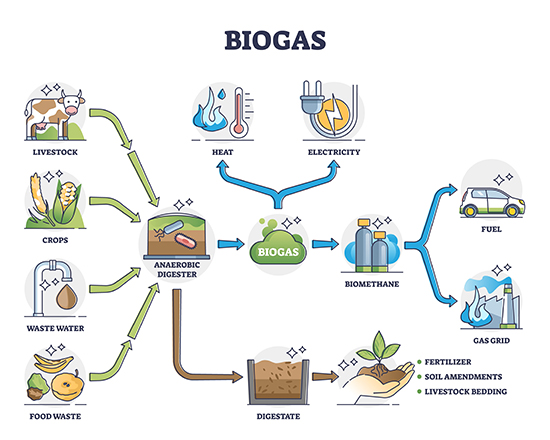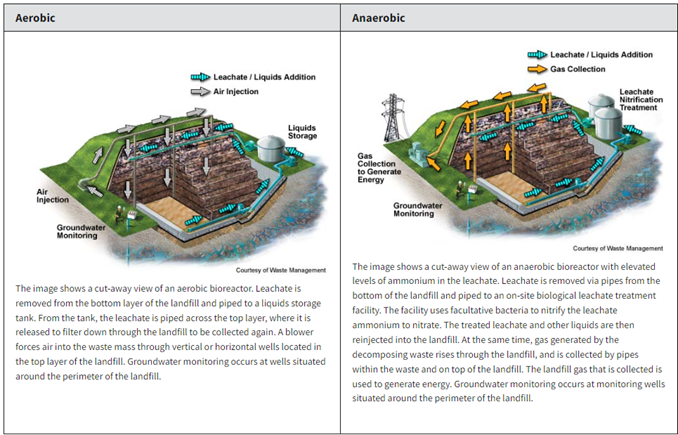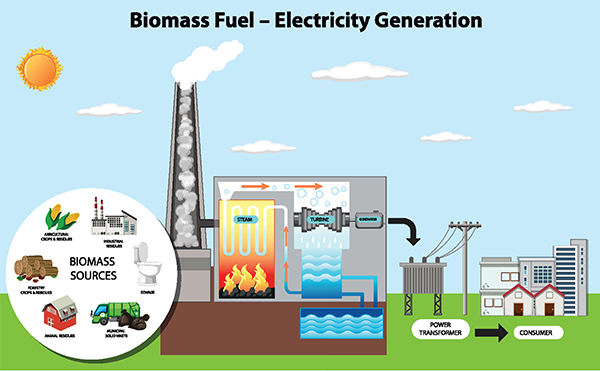Aerobic and Anaerobic Digestion
What is The Difference?
Biodegradation is the breakdown of organic matter by microorganisms. Stated otherwise, any organic matter that can be broken down by microorganisms is biodegradable. This is a natural process. Light, pressure, temperature, and chemicals in the environment contribute to the weakening of the properties of the organic matter, hence reducing the solidity of the item. Imagine a rose petal that falls from the flower. Without its nutrient sources it withers in heat and sunlight. It may be walked on and crushed into pieces (known as the biodeterioration stage). Microbes, which exist everywhere, begin to digest the pieces (known as the biofragmentation stage). All very natural, simplified by the example of a tiny rose petal.
Now imagine this process on a much larger scale, a landfill for instance, specifically a municipal solid waste landfill (MSWLF). There are landfills focused on waste compaction with layering, often referred to as dry-tomb landfills. These are typically older properties. Newer versions of landfills are designed through skillful engineering with features to protect the surrounding environments, contribute to a circular economy, and expedite the decomposition and stabilization of the waste. These are known as bioreactor landfills.
There are two kinds of bioreactor landfills, and both introduce liquid into the process which accelerates waste degradation. Moisture is the single most important factor in promoting accelerated decomposition. Liquids help stimulate the natural biodegradation process whereby bacteria break down the waste. Liquids leach out from heavy metals, dissolved solids, organics, and more. Have you ever discovered a corroded battery in the bottom of a drawer? That stuff that leaked out is, well, nasty! Imagine similar but in the size of a landfill! Liquids from the decomposing wastes naturally flow downward and are collected to be recirculated across the top layer. Leachate is the term given when rainwater filters through buried waste. It leaches, or draws out, chemicals from the waste.
Leachate from bioreactor landfills contains high concentrations of ammonia and organics, as you might imagine. This is one reason it is recirculated as it is heavily polluted. Prior to being redistributed, it is treated on-site as opposed to being hauled to a hazardous waste treatment facility. Obviously, less hauling reduces cost. However, the technology for the treatment process and the engineering support for the on-site process doesn’t come without their own costs. Nevertheless, repurposing leachate aids in reducing greenhouse gas emissions, reduces environmental risks, and yields economic benefits.
There are two significant processes for bioreactor landfills to operate properly, and the key difference in the two processes is oxygen, which plays a major role. Both processes recirculate leachate. Both reactions produce gas (carbon dioxide), liquid (water), some solid residue (compost), and new biomass. When oxygen is present biodegradation is known as aerobic digestion. When no oxygen is present the term is anaerobic digestion. In both instances, leachate is collected through a series of pipes, engineered to be pumped from the bottom floor back to the top to be prepared for recirculation. In fully optimized bioreactor landfills, additional liquids supplement the moisture controls and can include storm water, wastewater, and wastewater treatment plant sludges.
Aerobic digestion includes injecting air into the waste mass via wells, engineered in either vertical or horizontal positions. This promotes the natural occurring microbial activity. When combined with controlled moisture content, microbes break down the waste most efficiently. The pumping of air accelerates the process making aerobic digestion faster than anaerobic digestion. In the absence of air, decomposition takes longer. Special temperatures are not necessary with aerobic digestion, ambient temps suffice. The process is less complex and easier to manage than anaerobic digestion. Bacteria rapidly consume organic matter, and digestion continues until the percentage of degradable solids is reduced to between 20% and 10% of their original mass, depending on local weather conditions.
 In an anaerobic bioreactor landfill, there is an absence of oxygen. Gases accumulate from the decomposing waste. Think of a soda or beer can. When opened for the first time, we hear, and sometimes feel, the gases escaping. They were trapped until exposed. In an anaerobic bioreactor landfill gases are trapped below the layers. Again, the engineering features a pipe system to collect the gas. Landfill gas (LFG) is primarily methane and is captured and used to generate energy. LFG or biogas is a popular source of renewable energy as it reduces greenhouse gas emissions.1 Additionally, with accelerated biodegradation, methane gas is produced at a much earlier stage and generates at a higher rate than a traditional or dry-tomb landfill. This potentially decreases long-term environmental risks, and overall operating costs.
In an anaerobic bioreactor landfill, there is an absence of oxygen. Gases accumulate from the decomposing waste. Think of a soda or beer can. When opened for the first time, we hear, and sometimes feel, the gases escaping. They were trapped until exposed. In an anaerobic bioreactor landfill gases are trapped below the layers. Again, the engineering features a pipe system to collect the gas. Landfill gas (LFG) is primarily methane and is captured and used to generate energy. LFG or biogas is a popular source of renewable energy as it reduces greenhouse gas emissions.1 Additionally, with accelerated biodegradation, methane gas is produced at a much earlier stage and generates at a higher rate than a traditional or dry-tomb landfill. This potentially decreases long-term environmental risks, and overall operating costs.
 Whether aerobic or anaerobic, when microbes consume the waste matter, energy is created. This energy is transferred to cells in the organism. All living organisms, including humans, need energy which is stored in cells. A universal energy source for all living cells is known as ATP or adenosine triphosphate.ATP is a chemical component that is responsible for energy transfer. In other words, ATP captures chemical energy produced by the microbes and delivers it to cells. To access the stored energy, cells break apart the ATP molecules. ATP is a nitrogen base (adenine) and a sugar molecule (ribose), which create adenosine, plus three phosphate molecules making ATP the most energy loaded composition for adenosine. When the phosphate bonds break apart, and if adenosine only has one phosphate molecule, it’s called adenosine monophosphate (AMP). If it has two phosphates, it’s called adenosine diphosphate (ADP).2 These phosphate molecules cycle over and over between energy creation and depletion – like charging a smartphone, the process is constant and continuous.
Whether aerobic or anaerobic, when microbes consume the waste matter, energy is created. This energy is transferred to cells in the organism. All living organisms, including humans, need energy which is stored in cells. A universal energy source for all living cells is known as ATP or adenosine triphosphate.ATP is a chemical component that is responsible for energy transfer. In other words, ATP captures chemical energy produced by the microbes and delivers it to cells. To access the stored energy, cells break apart the ATP molecules. ATP is a nitrogen base (adenine) and a sugar molecule (ribose), which create adenosine, plus three phosphate molecules making ATP the most energy loaded composition for adenosine. When the phosphate bonds break apart, and if adenosine only has one phosphate molecule, it’s called adenosine monophosphate (AMP). If it has two phosphates, it’s called adenosine diphosphate (ADP).2 These phosphate molecules cycle over and over between energy creation and depletion – like charging a smartphone, the process is constant and continuous.
How does this fit in with our initial discussion? Cells break apart more ATP molecules when oxygen is present, hence more energy is released. As such, a major advantage of aerobic digestion, which utilizes oxygen, is the amount of energy released. The presence of oxygen allows the organisms to break down the matter directly to carbon dioxide. As such, aerobic digestion produces carbon dioxide more rapidly than anaerobic digestion.
Anaerobic digestion, which lacks oxygen, reduces the microorganism’s efficiency. Without oxygen, anaerobic digestion only releases enough energy to make two ATP phosphate molecules. As stated, the ATP, AMP, ADP phosphate molecules are constantly cycling back and forth, which allows the process to continue. The process just works longer to produce the outcome.
Ironically, landfills contribute to fossil fuels. Millions of years ago, earth’s atmosphere had very little oxygen. Once oxygen became more abundant (photosynthesis), cells created more energy and essentially, chocked out some of the anaerobic microorganisms. The microorganisms eventually die. Over millions of years, which is a blink of an eye in earth time, the earth recycles itself through subduction and the tectonic process. The remains of these organisms, ourselves included, are transformed into what we know today as fossil fuels.
As noted, aerobic digestion is more rapid than anaerobic but requires larger landfill space. The air space needed in an aerobic environment must accommodate for air wells, which take up space and prevent the waste from being compacted as tightly as in an anerobic environment. In an anaerobic landfill as layers are compacted, the combined degree of the compacted layers, that is the density of the waste mass, creates landfill airspace, or room for more waste layers thus allowing for landfills requiring less total space.
Nearly all the biogas consumed in the United States is produced from anaerobic decomposition and used for electricity generation.3
 What is commonly referred to as second-generation bio-mass (organic material made by living organisms or microbes) or non-edible bio-wastes, or non-food raw material, is converted into fuel. Biogas can be burned directly as a fuel or scrubbed to remove CO2 and other gases for use just like natural gas. Phases in the conversion process include pretreatment, enzymatic hydrolysis, and fermentation. These methods are extensive but are still considered less costly when compared to converting fossil fuel for energy. Some sewage treatment plants, and industrial facilities collect and use biogas to heat the digesters in anaerobic bioreactors. Some use it to generate electricity for their own use or to sell.
What is commonly referred to as second-generation bio-mass (organic material made by living organisms or microbes) or non-edible bio-wastes, or non-food raw material, is converted into fuel. Biogas can be burned directly as a fuel or scrubbed to remove CO2 and other gases for use just like natural gas. Phases in the conversion process include pretreatment, enzymatic hydrolysis, and fermentation. These methods are extensive but are still considered less costly when compared to converting fossil fuel for energy. Some sewage treatment plants, and industrial facilities collect and use biogas to heat the digesters in anaerobic bioreactors. Some use it to generate electricity for their own use or to sell.
The U.S. Energy Information Administration (EIA) estimates that in 2021 about 232 billion cubic feet (Bcf) of landfill gas was collected at 311 U.S. landfills and burned to generate about 9.4 billion kilowatt hours (kWh) of electricity. This was equal to about 0.2% of total U.S. utility-scale electricity generation in 2021. (Note the referenced article includes separate data from sewage and industrial wastewater treatment plants as well as data from dairy and livestock operations.) Preliminary data for 2022 from the EIA is reported below for major energy sources. 
1 Note: While capturing LFG to convert to renewable energy is of value, carbon is still being released into the atmosphere.
2 ATP: How It Works, How It's Made, and Why It's Important (verywellhealth.com)
3 Biogas-Renewable natural gas - U.S. Energy Information Administration (EIA)

